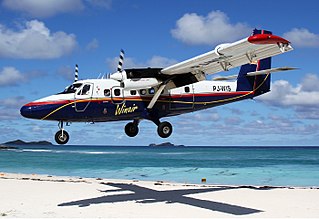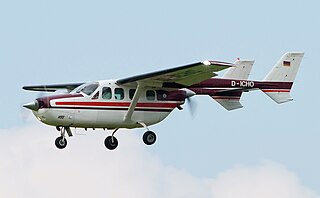| Industry | Aerospace |
|---|---|
| Founded | 1990 |
| Headquarters | , |
| Products | Military, transport and civilian aircraft |
Aeroprogress is a Russian aircraft design company based in Moscow. Aircraft are certified by subsidiary company the ROKS-AERO Aviation Design Bureau.
Twin-engined passenger/cargo aircraft for 9-12 passengers. [1]

Blackburn Aircraft Limited was a British aircraft manufacturer that concentrated mainly on naval and maritime aircraft during the first part of the 20th century.

The Cessna 208 Caravan is a utility aircraft produced by Cessna. The project was commenced on November 20, 1981, and the prototype first flew on December 9, 1982. The production model was certified by the FAA in October 1984 and its Cargomaster freighter variant was developed for FedEx. The 4 ft (1.2 m) longer 208B Super Cargomaster first flew in 1986 and was developed into the passenger 208B Grand Caravan.

The de Havilland Canada DHC-6 Twin Otter, currently marketed as the Viking Air DHC-6 Twin Otter, is a Canadian 19-passenger STOL utility aircraft developed by de Havilland Canada, which produced the aircraft from 1965 to 1988; Viking Air purchased the type certificate, then restarted production in 2008. The aircraft's fixed tricycle undercarriage, STOL capabilities, twin turboprop engines and high rate of climb have made it a successful commuter passenger airliner as well as a cargo and medical evacuation aircraft. In addition, the Twin Otter has been popular with commercial skydiving operations, and is used by the United States Army Parachute Team and the United States Air Force's 98th Flying Training Squadron.

The de Havilland Canada DHC-3 Otter is a single-engined, high-wing, propeller-driven, short take-off and landing (STOL) aircraft developed by de Havilland Canada. It was conceived to be capable of performing the same roles as the earlier and highly successful Beaver, including as a bush plane, but is overall a larger aircraft.

The Cessna Skymaster is an American twin-engine civil utility aircraft built in a push-pull configuration. Its engines are mounted in the nose and rear of its pod-style fuselage. Twin booms extend aft of the wings to the vertical stabilizers, with the rear engine between them. The horizontal stabilizer is aft of the pusher propeller, mounted between and connecting the two booms. The combined tractor and pusher engines produce centerline thrust and a unique sound. The Cessna O-2 Skymaster is a military version of the Cessna 337 Super Skymaster.
SIAI-Marchetti was an Italian aircraft manufacturer primarily active during the interwar period.
De Havilland Aircraft of Canada Ltd. is an aircraft manufacturer with facilities based in the Downsview area of Toronto, Ontario, Canada. The original home of de Havilland Canada was the home of the Canadian Air and Space Museum located in what is now Downsview Park.
The Société des Ateliers d'Aviation Louis Bréguet also known as Bréguet Aviation was a French aircraft manufacturer.

Pacific Aerospace Ltd (PAL) is an aircraft manufacturing company based in Hamilton, New Zealand. Along with its predecessors, it has produced around 600 utility, training and agricultural aircraft.

The PAC P-750 XSTOL, is a utility aircraft of conventional all-metal low-wing monoplane design, with fixed tricycle undercarriage. Combining the engine and wings of the PAC Cresco with a new large fuselage and modified tail, all versions to date have been powered by a 750 hp (560 kW) Pratt & Whitney Canada PT6 turboprop. It is designed and manufactured in Hamilton, New Zealand by Pacific Aerospace Limited.

The PZL M28 Skytruck is a Polish STOL light cargo and passenger plane, produced by PZL Mielec, as a development of licence-built Antonov An-28s. Early licence-built planes were designated PZL An-28. The maritime patrol and reconnaissance variants are named PZL M28B Bryza.
The Yakovlev Yak-58 is a small, multi-role utility transport and business aircraft. The aircraft features a pusher engine and twin boom tail. It saw limited production in the late 1990s.

The Mississippi State University XV-11A Marvel was an experimental American STOL research aircraft of the 1960s. The MARVEL (Mississippi Aerophysics Research Vehicle with Extended Latitude) was a single-engined pusher monoplane fitted with a boundary layer control system. The first all-composite aircraft, it carried out its initial program of research on behalf of the US Army in the late 1960s, and was rebuilt in the 1980s as a proof-of-concept for a utility aircraft.

The Krunichev T-411 Aist is a Russian light utility monoplane designed by the Russian company Aeroprogress and placed into production by the Khrunichev State Research and Production Space Center. A version is marketed in the United States as the Aeroprogress T-411 Wolverine powered by a Continental TSIO-550-B.

The Creative Flight Aerocat is a Canadian mid-wing, all composite, four passenger experimental aircraft that can be configured for amphibious float operations. Under development since 1998, the aircraft is intended to be supplied in kit form by Creative Flight of Haliburton, Ontario, for amateur construction. The company has since been renamed Auriga Design.
The Bede BD-3 is a prototype six passenger homebuilt aircraft.
The Saturn/Lyulka AL-34 was an unbuilt turboshaft/turboprop engine for rotary and fixed-wing aircraft, proposed by the Soviet Union in the early 1990s. In turboprop form, the engine was offered for light aircraft such as the Sukhoi Su-86 eight-passenger business airplane, the Myasishchev M-101T Gzhel business jet, the ROS-Aeroprogress T-101 Grach nine-passenger aircraft, its derivative T-108 Zolotoy Orel nineteen-passenger aircraft, and the Krunichev T-511 "AIST-M". As a turboshaft, the AL-34 was proposed to power the Mil Mi-54 and the Kazan Ansat helicopters. The engine was also considered for unconventional aircraft such as the Mil Mi-30L Vintoplan tiltrotor aircraft, and it was to be an auxiliary engine for powering the boundary layer control system and air cushion on the EKIP flying saucer.